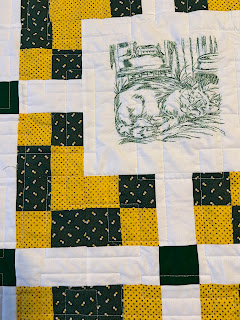Jacket 4 – Internal construction
There are a number of steps to constructing the inside support for the jacket. The first is applying the interfacing. In most of my garment sewing, I use fusible interfacing. It comes in a variety of weights and is quick to apply. But it is not so good for a fine wool jacket. I tried once using fusible horsehair canvas on a jacket front (for myself) and it wasn’t good. The fabric was stiff as a board! I reheated it and pulled it out and started over with a sew in. Based on this experience and everything I have read about men’s jackets, I am using a “sew-in” interfacing. I am using hymo canvas, which does not have animal hair woven into it, to create a full floating canvas. This piece covers the jacket front from the shoulder seam and lapel to the front hem,
Wikipedia
(https://en.wikipedia.org/wiki/Floating_canvas) says this about floating canvas:
In tailoring, a floating
canvas is a fabric panel sewn inside the
front of a suit jacket or coat. The floating canvas
adds structure to the front panel of a jacket, and ensures that the jacket
drapes properly and maintains its shape over time. It is traditionally made
from horsehair, woven together with wool, cotton, linen, or synthetic fibers. The horsehair
is used on the weft, and the other
fabric on the warp. The floating canvas is loosely handstitched in place
between the outer jacket fabric and the inner lining.
That is a good description of what I am doing. The interfacing piece is placed on the wrong
side of the jacket front; basted in place; catch stitched along the shoulder
and side seam, the front seam below the roll line, and at the hem. (Picture
4-1) The roll line has a woven tape applied next to
it by machine and then the long edges of the tape are whipped stitched to keep
it from rolling. (Picture 4-2) Next the lapel area is pad stitched to give it
structure. The shoulder, neck, and lower
front seam areas are taped for stability.
The final step is to create the chest pieces by adding pieces of
horsehair canvas (stiffer than hymo) and domette (a very thin fleece) to the
shoulder areas to keep the jacket from collapsing into the chest.
Picture 4-1
What is a chest piece (shield)?
https://gorgeousfabrics.com/blogs/gorgeous-fabrics-blog/tailoring-tips-chest-shieldsand-sleeve-heads)
says this:
A chest shield is a layer (or layers) of interfacing that
gives body to the upper chest area of a garment. A chest shield is generally
cut in the same shape as the upper chest part of the pattern. It can be a
single layer of interfacing, or, if there is a pronounced hollow above the
breast area, you can pad it with batting or several layers of interfacing.
Chest shields are quite common in men's jackets, and they are de rigeur
in bespoke tailoring and couture tailleur
garments.
Well, I have completed all the above and now have two jacket
fronts (right and left – always good to check).
(See picture 4-3.) With the
attachment of a few more pieces of interfacing, I will have all the pieces/parts
for the jacket. The back hem is
interfaced with hymo and the upper back has a half interfacing of light
cotton. Each of the sleeve section hems
is also interfaced with hymo. Putting
the outer jacket together and setting the sleeves is the next challenge; then
creating the inside pocket and finishing the lining.
Update on thread and chalk.
The Sewers Aid worked well but it is not all that convenient to dip the
needle in the bottle and treat the thread.
Thread Magic is another product to treat thread. It comes in a little jar with slots on the
side where the thread can be pulled through.
This works a lot easier and the “magic” stuff keeps the thread from
knotting up and twisting. The tailor
chalk is a wax-based marker that is supposed to disappear with heat. The white chalk does disappear completely
with heat; but the red and blue chalk not so much. I use the red and blue to mark lines on the
interfacings and these lines did not disappear completely. So, my recommendation is to always test
first.
I’ll be back with jacket shell next and comments on putting final
pieces together.
*This is the 4th post in a series written by ASG member, Sandy Herman about making a tailored jacket for her husband.





Comments
Post a Comment